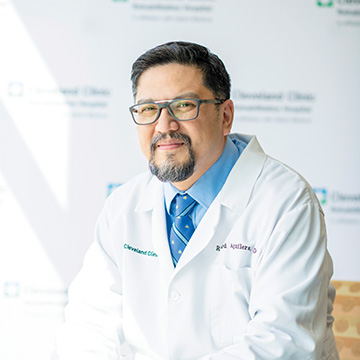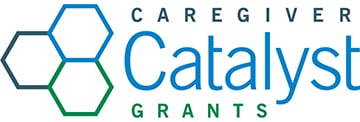CATALYST GRANTS
Robotics Reinvents Rehabilitation
By Chloe Maxwell
Patient Peter Evans uses a robotic glove with help from Dr. Richard Aguilera. | Photo: Lisa DeJong
THE FACTS
In the past several years, various technological innovations in rehabilitation have involved robotics. Richard Aguilera, MD, of Cleveland Clinic’s Department of Physical Medicine and Rehabilitation identified the importance of staying current on this evolving trend and submitted his Rehabilitation Robotics and Technology Initiative for a Catalyst Grant in 2020. He was awarded $8,200.

"This grant allowed us to put innovation into action. I could now offer my patients a diversified approach in achieving their rehabilitation goals, using traditional techniques as well as modern techniques that are in tune with the times. The technologies created an environment of excitement and curiosity, fostered creativity and brought forth new ideas."
— Dr. Richard Aguilera

Cleveland Clinic’s CATALYST GRANTS pool donations to fund the brightest ideas from our caregivers to improve patient outcomes and experiences. To date, 178 grants have been awarded, representing a total of $8.1 million in support.
THE NEED
Robotics is being used in rehabilitation in a variety of settings. Different types of robotic gloves can improve hand function for patients with severe hand impairments as a result of a brain injury or a stroke. For patients with locked-in syndrome (a rare neurological disorder characterized by paralysis of voluntary muscles) or amyotrophic lateral sclerosis (aka Lou Gehrig’s disease), robotic platforms can be used to mount devices with apps that allow users to communicate by blinking their eyes. All of the above devices were part of Dr. Aguilera’s grant.
THE IDEA
The Rehabilitation Robotics and Technology Initiative sought to increase access to rehab robotics to offer advanced patient interventions, improve patient outcomes and facilitate more medical education and research. The technologies were to be used as training tools for occupational therapists, physical therapists, respiratory therapists and speech therapists, as well as physicians, nurses, residents and medical students.
THE IMPACT
Dr. Aguilera’s grant connected patients with rehab robotics at four Cleveland Clinic locations. The initiative also provided invaluable training for caregivers in this rapidly evolving field and opened avenues for further research opportunities.
Catalyst Grant Spotlight: A new treatment offers new hope for children with peanut allergy.
Catalyst Grant Spotlight: The Discharge with Dignity program provides clothing and other essentials for patients in need.
Catalyst Grant Spotlight: Adapted bikes help children with disabilities build coordination and strength.
